Commercial Roofing Solutions – Your Comprehensive Guide
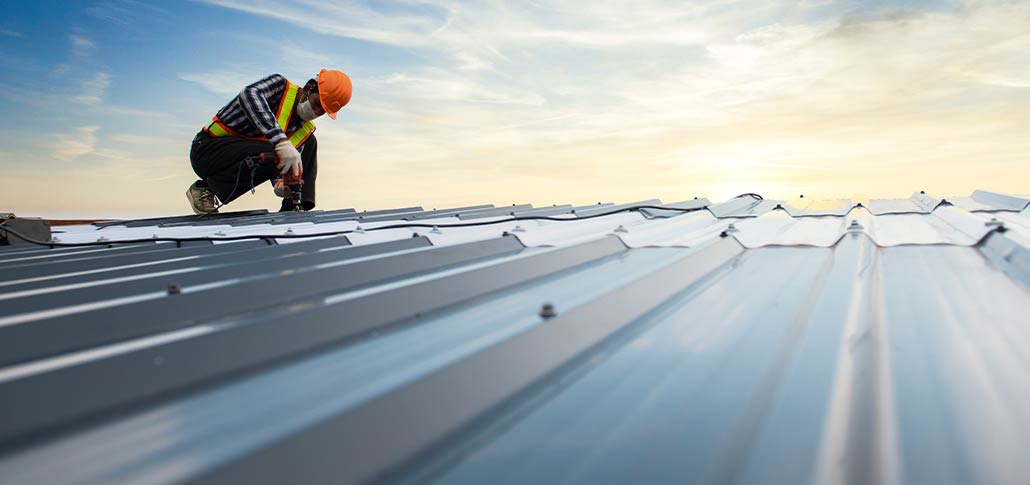
Choosing the right roofing solutions for commercial buildings is essential for protecting your business, minimizing expenses, and enhancing energy efficiency.
The best commercial roofing solutions in Connecticut for 2025 prioritize durability, cost-effectiveness, and sustainability. Neighboring states like Massachusetts and Rhode Island also share similar climate challenges and building needs, making it crucial to consider state-specific roofing solutions to protect your investments. By selecting the right materials and maintenance strategies, you can safeguard your property against weather damage, prevent energy loss, and avoid costly repairs.Top solutions in Connecticut include solar-ready options, energy-efficient materials, and maintenance practices to extend your roof’s lifespan and enhance your property’s value.
This comprehensive guide explores the best roofing options, essential maintenance tips, and emerging trends for 2025, empowering you to make an informed decision for long-term savings and efficiency.
Signs It’s Time to Replace Your Commercial Roof
A well-maintained commercial roof protects your building, reduces energy costs, and ensures long-term structural integrity. Knowing when to replace it can help you avoid costly repairs and business disruptions, especially in Connecticut’s challenging weather conditions.
1. Visible Damage (Cracks, Leaks, Mold)
Connecticut’s weather, including heavy snow, rain, and humidity, can cause significant damage to commercial roofs. Similarly, Massachusetts and Rhode Island experience harsh winters with heavy snowfall, and coastal areas in Rhode Island are exposed to saltwater, which can deteriorate roofing materials. If your roof shows signs of cracks, leaks, or mold growth, it may be time for a replacement.
Winter freeze-thaw cycles can exacerbate these issues, leading to structural concerns.
Regular inspections help identify weak spots before they worsen. If leaks persist despite repairs, consider upgrading to a durable roofing system like TPO or EPDM for long-term protection and energy efficiency.
2. Rising Energy Costs
An aging or damaged commercial roof can compromise insulation, causing heating and cooling inefficiencies. Connecticut’s cold winters and hot summers make energy efficiency crucial. If your energy bills have been steadily increasing, your roof may be allowing excessive heat transfer.
Reflective roofing materials like TPO can help reduce cooling costs by reflecting UV rays, while EPDM provides superior insulation for colder climates. Investing in a modern, energy-efficient roofing system can lead to substantial savings on utility expenses over time.
Request A Free Quote
Speak To Our Roofing Specialists Today!
National Roofing & Solar offers expert commercial roof replacements, leak repairs, and solar upgrades, maximizing energy efficiency and ROI.
3. Structural Concerns
In Connecticut, heavy snowfall and ice dams can lead to pooling water, sagging roofs, or even structural collapse if not addressed. A well-maintained drainage system is crucial for extending your roof’s lifespan and preventing winter damage.
If your roof structure is compromised, replacing it with a reinforced solution tailored to your building’s needs ensures safety and long-term durability. Professional roof assessments can determine the best materials and strategies for your commercial property.
Commercial Roof Replacement vs. Repair
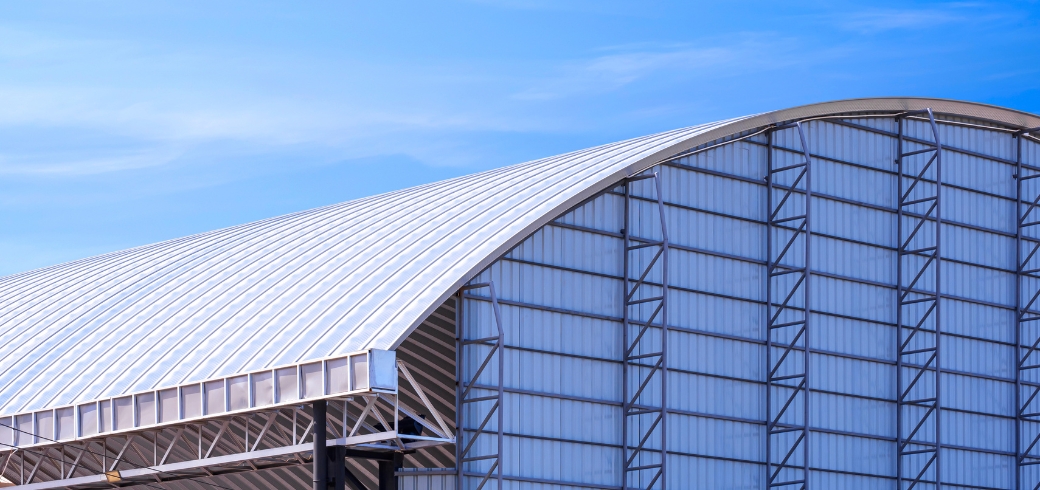
Deciding whether to repair or replace a commercial roof can be challenging. In Connecticut, factors like harsh winters, humid summers, and state building codes influence this decision.
How to Decide Whether to Repair or Replace
Deciding between a commercial roof repair or replacement depends on factors like roof age, damage extent, and maintenance history. Minor leaks, punctures, or surface damage often warrant repairs, extending the roof’s lifespan.
However, if the damage is widespread, the roofing system is over 20 years old, or repairs become frequent, a replacement is more cost-effective. A professional inspection can help determine the best commercial roofing solutions based on structural integrity and long-term financial benefits.
Signs Your Roof Needs Replacement
Visible sagging, persistent leaks, and ponding water are key indicators that a commercial roof may need replacement. If roofing materials like TPO or EPDM exhibit extensive cracks, blistering, or detachment from the substrate, a full replacement may be necessary.
Another warning sign is excessive energy costs due to poor insulation. Regular inspections can identify these red flags early, preventing structural damage and costly emergency repairs.
Cost Comparison: Short-Term vs. Long-Term Savings
Roof repairs offer immediate cost savings, often costing thousands less than a full replacement. However, recurring repairs add up, making a replacement the better investment over time. A new roofing system increases energy efficiency, reduces maintenance costs, and enhances property value.
For example, a TPO or EPDM roof replacement can yield long-term savings through lower cooling costs and fewer repairs, making it a cost-efficient choice over decades.
Explore our expert commercial roofing solutions and find the best fit for your business.
Request A Free Quote
Speak To Our Roofing Specialists Today!
National Roofing & Solar offers expert commercial roof replacements, leak repairs, and solar upgrades, maximizing energy efficiency and ROI.
Quick Overview of Roof Maintenance
Regular maintenance is essential for extending the lifespan of commercial roofing systems and preventing costly repairs. For businesses in Massachusetts and Rhode Island, additional attention should be given to saltwater exposure, especially for coastal properties. Regular cleaning and the use of corrosion-resistant materials are critical to ensuring your roof withstands both winter conditions and saltwater corrosion.
Here are key maintenance practices every business should follow:
- Preventive Maintenance: Routine cleaning, minor repairs, and early leak detection help prevent major damage. Keeping drains clear and addressing small cracks can reduce the risk of water infiltration. Scheduling professional maintenance twice a year ensures roofing materials stay in top condition.
- Inspections: Regular inspections can help identify potential issues before they become costly problems. Roofing professionals assess seams, flashings, and drainage systems to maintain proper functionality. After severe weather events, additional inspections can catch hidden damage early.
- Seasonal Maintenance (Weather, Ice, Wind, etc.): Different seasons pose unique challenges for commercial roofs. In summer, UV rays can deteriorate roofing materials, while winter brings ice dams and heavy snow loads. Proper winterizing, such as installing heat cables and clearing snow buildup, prevents structural damage. Windstorms can loosen fasteners, requiring prompt repairs.
- Signs of Damage: Water stains on ceilings, mold growth, and bubbling on the membrane are common indicators of roofing problems. Gaps in flashing, deteriorating sealants, and ponding water can lead to severe structural issues if not addressed in time.
- Common Issues and Fixes: Frequent roofing problems include membrane punctures, seam separation, and poor drainage. Solutions range from applying liquid sealants for minor leaks to installing reinforced membranes in high-traffic areas. Upgrading insulation can also enhance energy efficiency and prolong the roof’s lifespan.
By implementing these maintenance practices, businesses can protect their investments and ensure long-term roof performance. Schedule a professional inspection today to keep your roof in top condition and avoid costly repairs.
Best Roof Options for Solar Installation
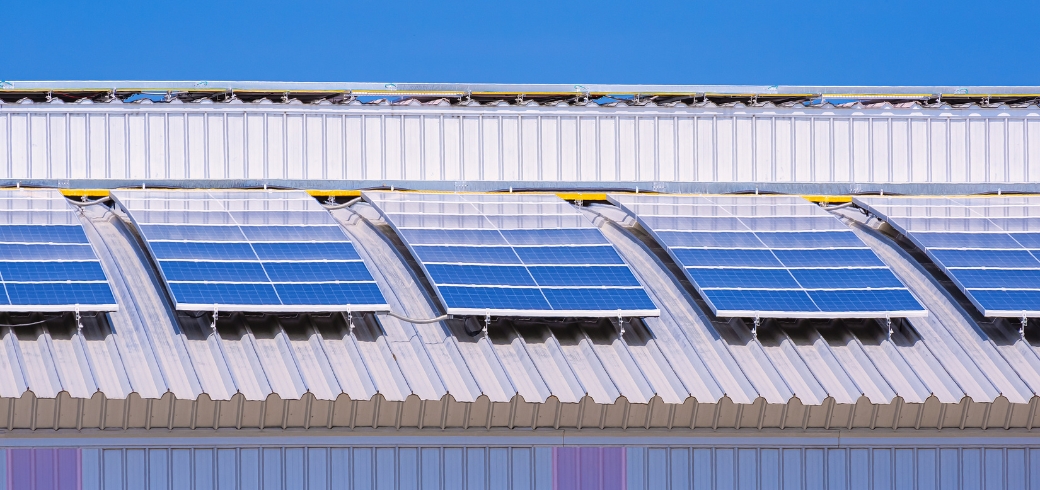
1. How to Determine If Your Building Is Solar-Ready
Before installing solar panels, assess your roof’s condition, orientation, and structural integrity. A flat or low-slope roof with minimal shading and strong load-bearing capacity is ideal. Consider local climate conditions and ensure your building complies with solar installation regulations. A professional roof inspection can confirm if modifications are needed for optimal solar efficiency.
2. Best Commercial Roofing Materials for Solar Integration
When it comes to installing solar panels, choosing the right roofing material is key.
Metal roofs are an excellent option due to their durability, long lifespan, and natural compatibility with solar mounting systems. For businesses in Rhode Island and Massachusetts, coastal regions demand additional durability, and metal roofs are particularly effective at resisting the corrosive effects of saltwater exposure.
Additionally, cool roofing materials with white reflective surfaces can enhance energy efficiency by reducing heat absorption. Selecting a sturdy, solar-friendly roof ensures maximum performance and long-term savings.
3. Financial Incentives, Tax Credits, and Costs
Federal and state incentives can significantly reduce solar installation costs.
The federal Investment Tax Credit (ITC) currently allows businesses to deduct a percentage of solar costs from taxes. Many states offer additional rebates, grants, and financing programs such as solar PPAs and tax-exempt bonds, making solar adoption financially viable for commercial properties.
Connecticut offers various state incentives for commercial solar installations, including rebates, grants, and financing programs such as solar PPAs and C-PACE financing. In addition, Massachusetts provides state-level incentives like the Massachusetts Clean Energy Center (MassCEC) programs, and Rhode Island businesses can take advantage of the Renewable Energy Fund to make solar installations more affordable.
Taking advantage of Connecticut’s Renewable Portfolio Standard (RPS) can further offset installation costs.
Request A Free Quote
Speak To Our Roofing Specialists Today!
National Roofing & Solar offers expert commercial roof replacements, leak repairs, and solar upgrades, maximizing energy efficiency and ROI.
4. Quick Overview of Solar Benefits
Solar panels lower energy costs, reduce carbon footprints, and provide energy independence. They enhance property value, offer potential tax incentives, and serve as a long-term investment with minimal maintenance. Commercial properties using solar energy can also benefit from net metering programs, further reducing electricity expenses.
Overview of Solar Maintenance
Proper solar maintenance ensures efficiency, longevity, and cost savings for your commercial system. Regular inspections and upkeep help prevent performance issues and unexpected repairs.
- Seasonal Care: Extreme weather conditions can impact solar panels. In winter, snow accumulation should be cleared, while in summer, panels should be checked for overheating or dust buildup.
- Preventive Care: Routine inspections, cleaning, and checking electrical connections help prevent system failures. Keeping panels free of debris and ensuring inverters function properly can maximize energy production.
- Long-Term Care: Over time, solar panels may experience wear and tear. Monitoring energy output, replacing aging components, and scheduling professional maintenance extend the system’s lifespan.
- Common Issues & Troubleshooting: Problems like decreased energy output, inverter malfunctions, and wiring issues can arise. Regular performance monitoring and timely repairs help avoid costly downtime.
Investing in proactive maintenance not only ensures maximum energy efficiency but also protects your long-term investment. A well-maintained solar system will continue to provide reliable and sustainable energy for years to come.
Keep your solar system efficient year-round! Schedule a free consultation today to protect your investment.
6 Types of Commercial Roofing Materials
Choosing the right roofing material for your commercial building is not just about aesthetics—it’s a critical decision that impacts the durability, energy efficiency, and long-term cost-effectiveness of your property. With so many options available, it’s essential to understand how each material performs and what benefits it brings to your specific building needs. Below is an in-depth look at some of the top commercial roofing materials based on years of industry expertise and current innovations.
1. PVC Roofing: Long-Lasting and Energy-Efficient
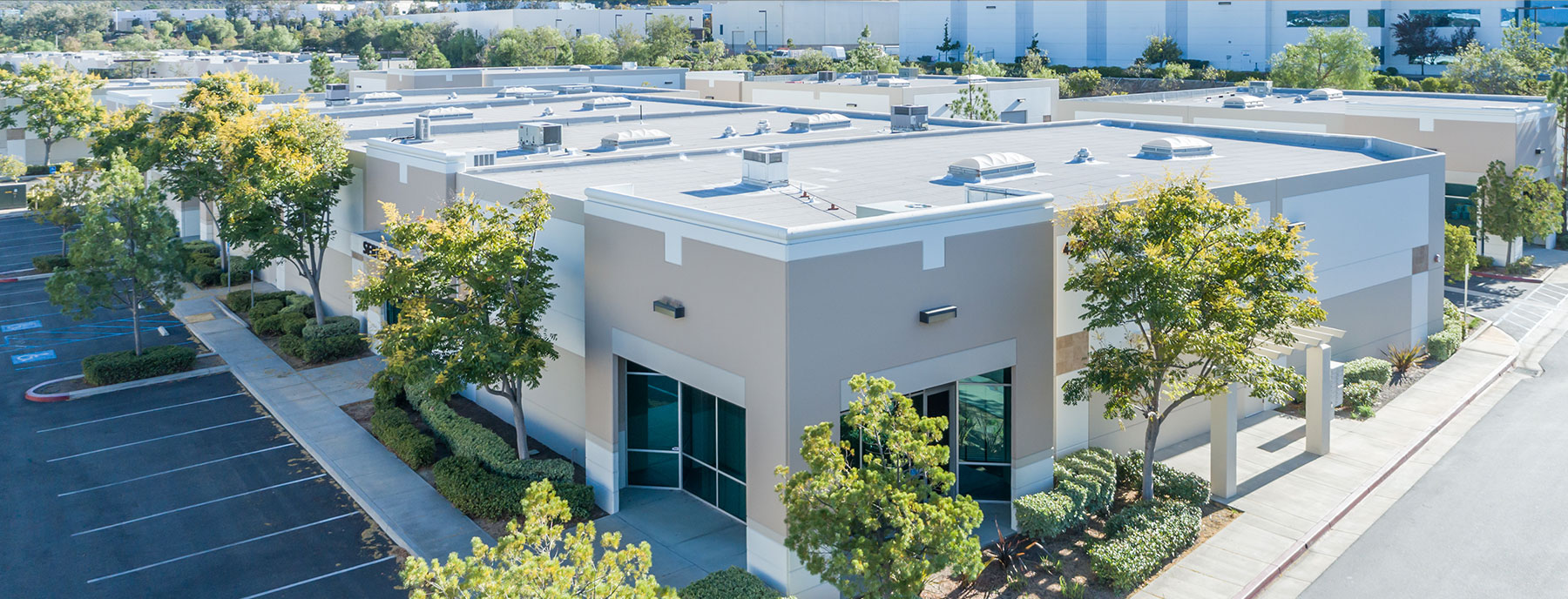
Polyvinyl Chloride (PVC) roofing is known for its outstanding durability, making it one of the most reliable choices for commercial buildings. This single-ply roofing membrane is designed to withstand harsh weather conditions, including extreme heat, cold, and even fire. Its high reflectivity is a major selling point, significantly reducing energy costs by keeping your building cooler during the hottest months. The material also resists chemical damage and punctures, making it ideal for buildings in areas where harsh environmental factors are a concern.
Why it stands out: Prefabricated PVC roofing systems are easy to install with fewer chances for error, meaning faster installation and lower labor costs. With a lifespan of over 20 years, it’s a durable and sustainable investment for any commercial property.
2. TPO Roofing: A Modern, Reflective Solution

Thermoplastic Olefin (TPO) is one of the fastest-growing commercial roofing materials in the market. TPO’s reflective properties help it to minimize heat absorption, which translates into lower cooling costs and increased energy efficiency for your building. Its resistance to UV rays, ozone, and weathering makes it a robust choice for roofs exposed to constant sunlight or harsh weather conditions.
TPO’s flexibility also allows for easier installation, and its energy-efficient coatings can significantly reduce indoor temperatures, improving the overall comfort of the building. TPO roofs are ideal for businesses looking to combine cost-effectiveness with sustainability.
Why it stands out: TPO is a highly versatile roofing material that’s also resistant to algae and dirt buildup, which means it can maintain its appearance for longer, requiring fewer repairs and cleaning over time.
Explore the science behind TPO and its applications in roofing.
Request A Free Quote
Speak To Our Roofing Specialists Today!
National Roofing & Solar offers expert commercial roof replacements, leak repairs, and solar upgrades, maximizing energy efficiency and ROI.
3. EPDM Roofing: Durable and Weather-Resistant
Ethylene Propylene Diene Monomer (EPDM) is a rubber-based roofing material that’s renowned for its extreme durability and resistance to a variety of environmental factors, including UV rays, extreme temperatures, and even chemical exposure. EPDM roofs have been trusted in commercial applications for decades, thanks to their low maintenance and long lifespan—often lasting 30 years or more with proper care.
This material is perfect for businesses that need a highly reliable roofing solution that can withstand tough weather conditions, including hail, snow, and intense heat. The ease of installation and maintenance of EPDM roofs make it a favorite for commercial buildings, especially in regions with fluctuating temperatures.
Why it stands out: EPDM is incredibly cost-effective while offering a superior return on investment due to its long lifespan and minimal upkeep.
Dive deeper into EPDM roofing and learn more about its benefits.
4. Asphalt Roofing: Affordable and Versatile
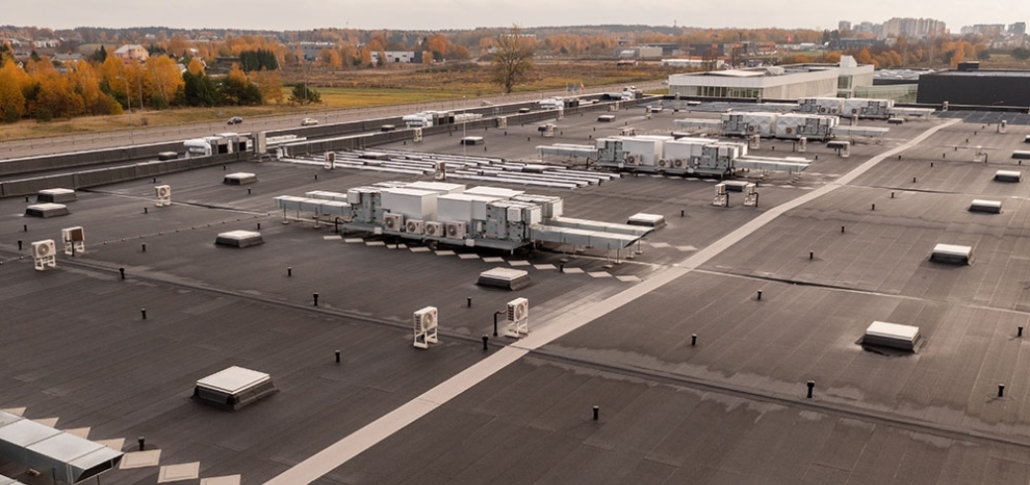
Asphalt roofing, including modified bitumen, is a time-tested solution for commercial properties. Its affordability and versatility make it an attractive option for businesses on a budget. Asphalt roofing is highly resistant to the elements, providing reliable protection against rain, snow, and strong winds. The material’s ability to expand and contract with temperature changes without cracking makes it a durable choice for buildings in regions with extreme weather fluctuations.
Why it stands out: Asphalt roofing’s easy installation and affordability, combined with its strong performance in adverse conditions, make it a reliable and budget-friendly option for many commercial properties.
5. Metal Roofing: High-Performance and Eco-Friendly

Metal roofing is becoming a popular choice for commercial buildings due to its exceptional durability and energy efficiency. Steel, aluminum, and copper options provide superior protection from wind, hail, and heavy snow. One of metal roofing’s standout features is its ability to reflect heat, reducing energy consumption in warmer climates. This not only lowers cooling costs but also extends the lifespan of your HVAC system.
Why it stands out: With a lifespan of 40 years or more and minimal maintenance, metal roofing is a cost-effective long-term investment that increases the structural integrity of your building. Additionally, its recyclability makes it an eco-friendly choice for businesses looking to reduce their carbon footprint.
6. Shingle Roofing: Classic and Cost-Effective
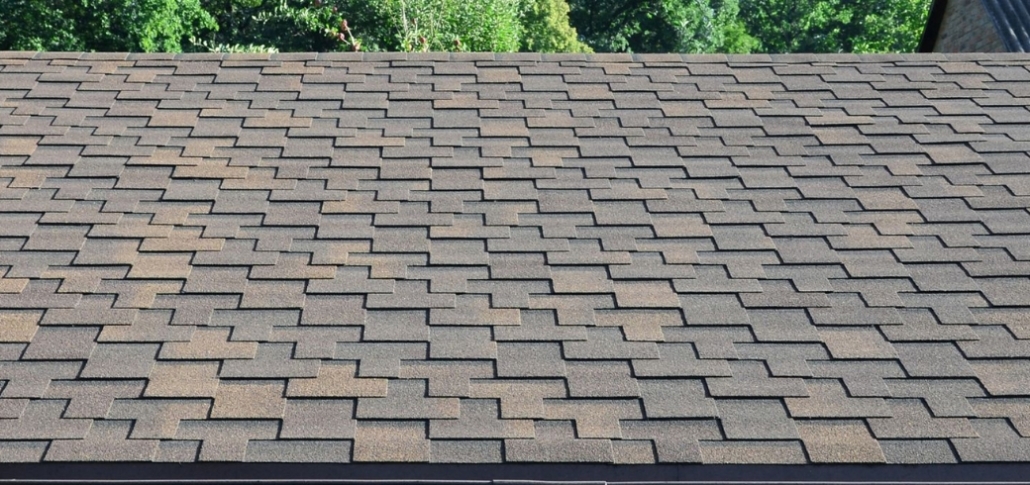
Though more commonly associated with residential properties, shingle roofing can also be a practical solution for certain commercial buildings, particularly those with steep roofs. Available in asphalt, metal, or synthetic materials, shingles are known for their aesthetic appeal and ease of installation. While they may not have the same lifespan as other commercial roofing materials, their affordability and versatility make them a popular choice for smaller commercial buildings or businesses in milder climates.
Why it stands out: Shingle roofs are low-cost, easy to repair, and can be installed quickly, making them ideal for smaller commercial projects or those needing a roof on a budget.
Request A Free Quote
Speak To Our Roofing Specialists Today!
National Roofing & Solar offers expert commercial roof replacements, leak repairs, and solar upgrades, maximizing energy efficiency and ROI.
Eco-Friendly Roofing Options: Sustainable and Green
As more businesses adopt sustainability initiatives, eco-friendly roofing has become a key consideration. Green roofs, which incorporate vegetation and sustainable materials, offer outstanding insulation and stormwater management properties. Not only do these roofs contribute to a building’s energy efficiency, but they also improve air quality and reduce the urban heat island effect.
Beyond the environmental benefits, green roofing systems can help businesses earn tax incentives and qualify for local rebates, making them an economically viable solution for many commercial property owners.
Energy-Efficient Roofing Solutions: Cutting Costs While Saving the Environment
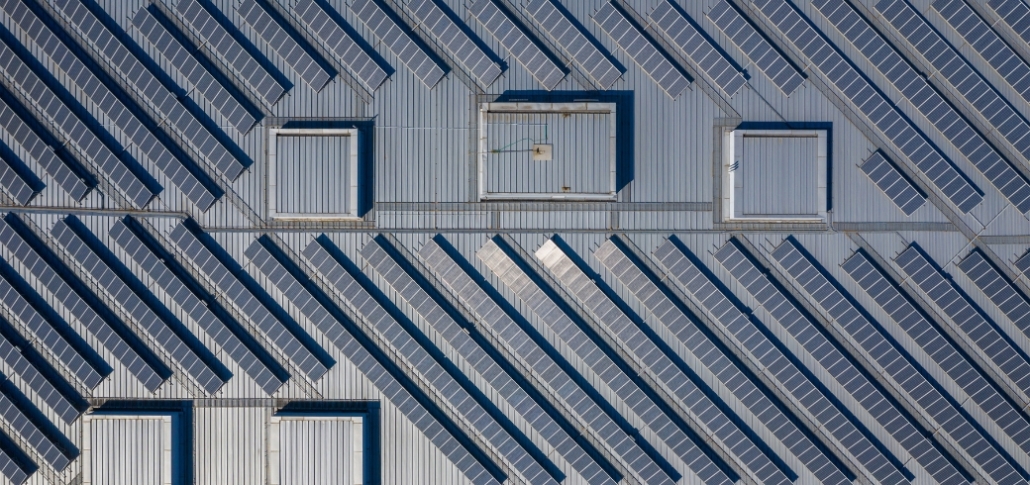
Roofing plays a critical role in the energy efficiency of a building. Cool roofs, which feature reflective coatings, are designed to reduce the amount of heat absorbed by the building, making them especially useful in hot climates. Materials like TPO and EPDM excel in this category, offering enhanced insulation that reduces the reliance on HVAC systems and lowers overall energy bills.
Cool roofs help businesses reduce their environmental impact while also lowering long-term operating costs, making them an excellent investment for forward-thinking companies.
Impact-Resistant Roofing: Protection from the Elements
For businesses located in regions with frequent storms, hail, or high winds, impact-resistant roofing materials provide superior protection. Options such as reinforced membranes and metal roofing can withstand extreme weather conditions, significantly reducing the risk of damage and the costs associated with repairs and maintenance.
Investing in impact-resistant roofing protects your property and ensures long-term structural integrity, particularly for businesses in storm-prone areas.
Location-Specific Considerations (CT & MA): Tailoring Your Roof to Local Conditions
Roofing needs vary greatly depending on geographic location.
For instance, in Connecticut, roofs must be able to handle heavy snow, rain, and fluctuating temperatures. As such, materials that offer strong thermal insulation, water resistance, and snow-shedding properties are a must. Connecticut businesses can also benefit from state incentives for eco-friendly and energy-efficient roofing options, including tax credits for solar-integrated roofing systems.
Why it stands out: Understanding the local climate and building codes ensures that your roofing solution is both functional and compliant, maximizing long-term performance while taking advantage of potential incentives.
Key Benefits of Commercial Roofing
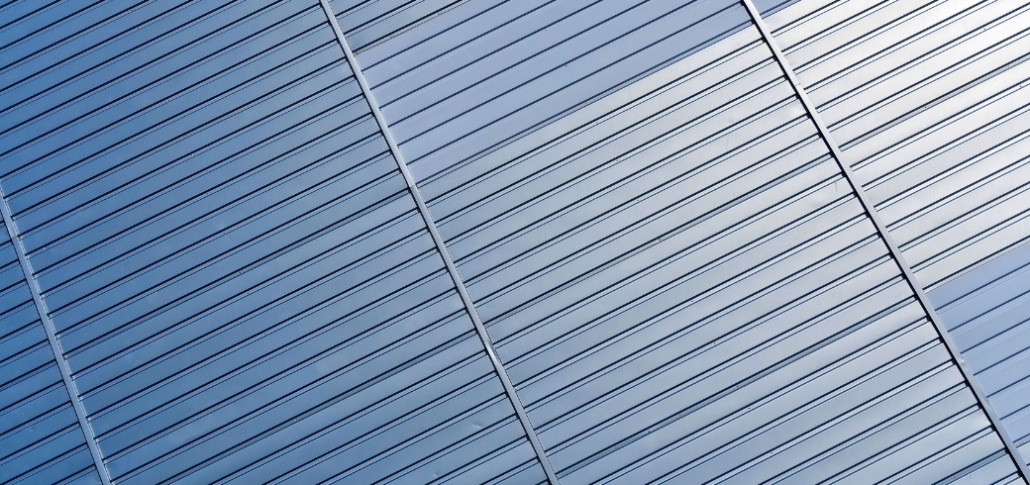
1. Cost-effectiveness vs. Longevity
Investing in high-quality commercial roofing solutions leads to long-term savings. While upfront costs may differ, durable materials like metal roofing help minimize maintenance and repair expenses over time.
Choosing the right roofing system helps businesses avoid frequent replacements, ultimately providing a greater return on investment (ROI). Prioritizing longevity over cheaper alternatives ensures cost savings and structural integrity.
2. Energy Savings and Reduced Utility Costs
Modern commercial roofing solutions, such as reflective coatings and insulation-enhanced membranes, significantly cut energy consumption. In Connecticut, this can mean substantial savings on heating during winter and cooling during summer.
Roofs designed for energy efficiency help regulate indoor temperatures, reducing the need for excessive heating or cooling.
This translates to lower utility bills and a more comfortable working environment, making it a smart investment for businesses aiming to improve sustainability and cost efficiency.
Request A Free Quote
Speak To Our Roofing Specialists Today!
National Roofing & Solar offers expert commercial roof replacements, leak repairs, and solar upgrades, maximizing energy efficiency and ROI.
3. Sustainability and Environmental Impact
Eco-friendly roofing options, such as green roofs and solar-integrated systems, promote sustainability while lowering carbon footprints. Using recyclable materials helps reduce landfill waste, while reflective surfaces minimize heat absorption, keeping buildings cooler and improving energy efficiency.
By choosing sustainable roofing, businesses can meet regulatory standards, attract eco-conscious clients, and contribute to a greener future.
4. Increased Property Value and Curb Appeal
A well-maintained commercial roof enhances the overall aesthetic appeal and structural integrity of a building. High-quality roofing materials boost property value, making it more attractive to potential buyers or tenants.
Additionally, a well-designed roof showcases professionalism, helping businesses create a lasting impression while ensuring long-term financial benefits. Get in touch today for a free consultation and discover the best roofing solution for your business!
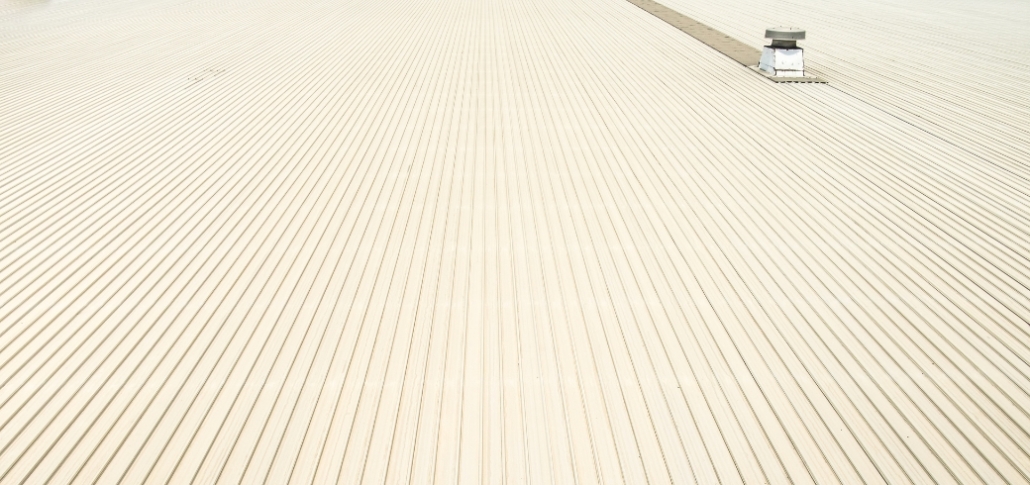
Commercial Roofing Trends for 2025
As the roofing industry evolves, businesses must stay ahead of the latest advancements. From cutting-edge materials to eco-friendly commercial roofing solutions and smart technology, here are the top trends shaping commercial roofing in 2025.
Innovations in Roofing Materials
Advancements in roofing materials are revolutionizing the industry. In 2025, expect to see stronger, more durable options like self-healing membranes and lightweight composite materials.
These innovations enhance longevity and weather resistance, reducing maintenance costs. Energy-efficient coatings and reflective materials are also on the rise, helping businesses lower cooling expenses while meeting environmental regulations.
Sustainability Trends in the Industry
The industry is shifting toward eco-friendly solutions such as green roofs, solar-integrated roofing, and recycled materials. Connecticut’s environmental regulations and incentives further encourage the adoption of sustainable practices.
Additionally, low-VOC adhesives and sustainable insulation materials are helping businesses meet LEED and ENERGY STAR standards.
Smart Roofing Technology
The integration of smart technology is transforming commercial roofing maintenance. Advanced sensors can now detect leaks, monitor insulation performance, and provide real-time weather resistance analysis.
Drones and AI-driven inspections are making roof assessments faster and more accurate. These innovations help businesses prevent costly damage while ensuring long-term efficiency and performance.
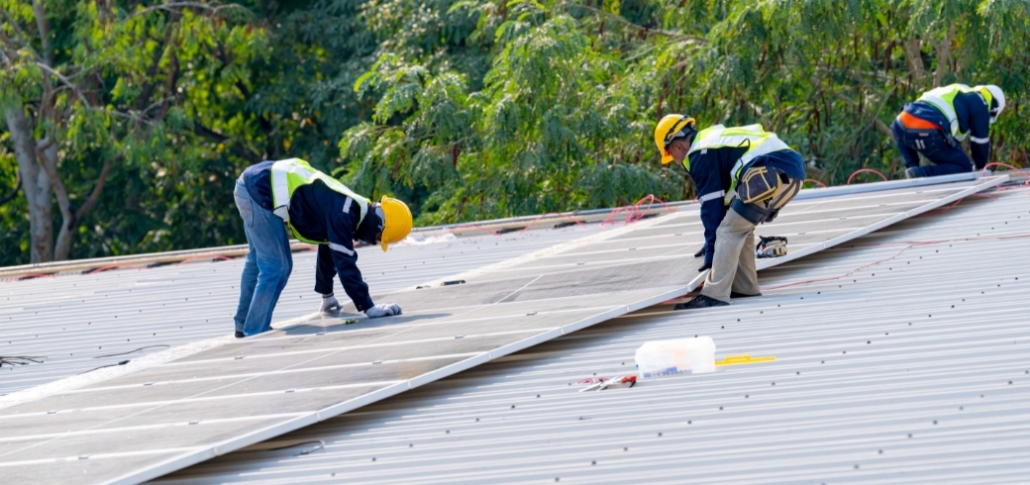
Case Studies & Success Stories in Connecticut
National Roofing & Solar Corporation has a proven track record of delivering exceptional commercial roofing solutions tailored to diverse business needs. Below are some illustrative case studies showcasing our expertise:
InSports Center
InSports Center, a premier sports facility in Trumbull, Connecticut, sought to reduce operational costs and enhance energy efficiency. We implemented a comprehensive roofing solution integrated with solar panels, financed through C-PACE. This project resulted in over $90,000 in expected annual savings, demonstrating our commitment to sustainable and cost-effective roofing solutions.
Shagbark Lumber
Shagbark Lumber aimed to modernize its facilities while minimizing environmental impact. Our team installed an energy-efficient roofing system complemented by solar technology, utilizing C-PACE financing. This initiative is projected to yield nearly $70,000 in annual savings, reflecting our ability to deliver eco-friendly solutions that also enhance profitability.
FAQs
The latest advancements in roofing technology include cool roofs, green roofs, and solar-integrated systems. Durable and energy-efficient materials like PVC and solar shingles are becoming increasingly popular for their ability to enhance sustainability and reduce energy costs.
TPO (thermoplastic olefin) is a single-ply roofing membrane commonly used for commercial buildings. It’s durable, UV-resistant, and energy-efficient, making it a cost-effective option for flat and low-slope roofs.
The future of roofing is moving toward sustainability and energy efficiency. Expect to see more solar roofing, green roofs, reflective coatings, and smart roofing technology that improves insulation and monitors roof health in real time.
The best choice depends on your specific needs. Some roofing materials offer better energy efficiency for warmer climates, while others provide durability and flexibility for colder regions. Consider factors like cost, lifespan, and weather resistance to determine the right option for your building.
Choosing the right commercial roofing material depends on your budget, climate, and building requirements. Some options offer excellent energy efficiency and durability at a competitive price, while others are known for their long lifespan and cost-effectiveness. Selecting the best material ensures long-term performance and value for your investment.
Have More Questions?
Choosing the right commercial roof solutions can be overwhelming, but we’re here to help. Contact our team today for expert advice on the best materials, energy-efficient options, and cost-effective solutions for your commercial roof.
Request A Free Quote
Speak To Our Roofing Specialists Today!
National Roofing & Solar offers expert commercial roof replacements, leak repairs, and solar upgrades, maximizing energy efficiency and ROI.
Get Started: Free Consultation & Inspection
Regular roof inspections help spot potential problems early, preventing them from turning into expensive repairs. A professional assessment ensures that your commercial roofing solutions are structurally sound, energy-efficient, and compliant with industry standards. Connecticut businesses benefit from inspections tailored to the state’s specific weather challenges and building codes.
Our consultation includes a comprehensive inspection of your commercial roof. Our experts assess materials, drainage systems, and potential damage, providing tailored solutions specific to Connecticut’s climate and regulations. You’ll receive a detailed report outlining recommended repairs or upgrades, ensuring transparency in our roofing solutions.
Get expert advice and a customized roofing plan for your business. Maximize your roof’s lifespan and savings in Connecticut — schedule your free expert inspection today!


